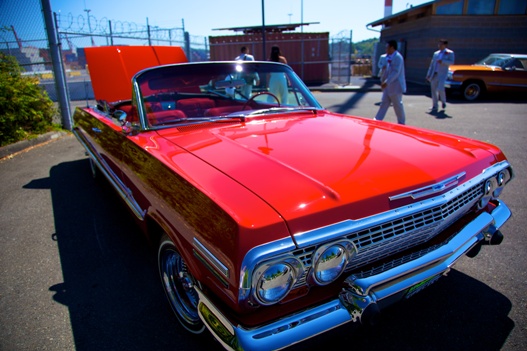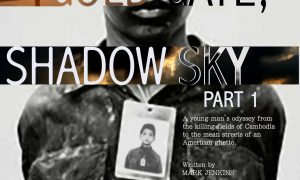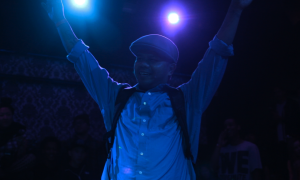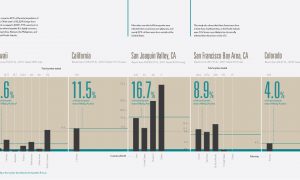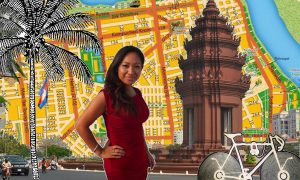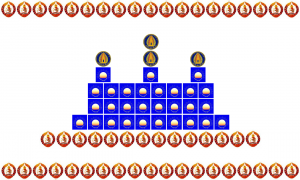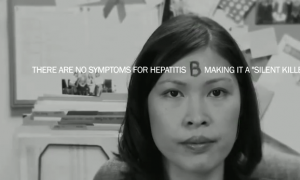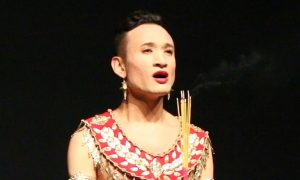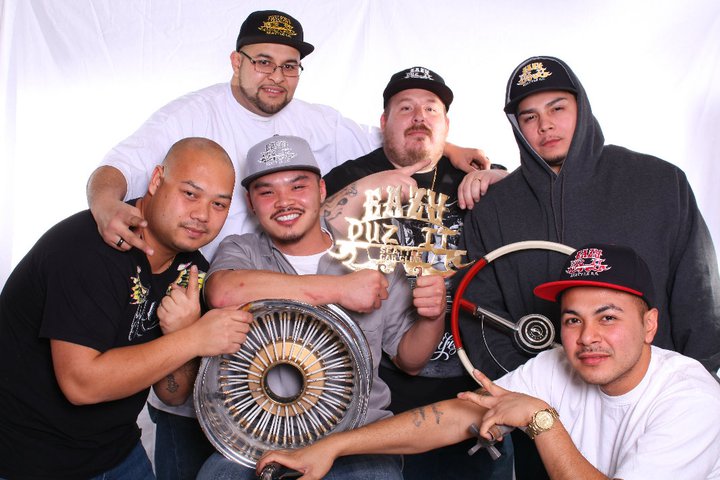
The club poses at its annual end of summer BBQ. Keo Sanh, bottom right. PHOTO: Bunthay Cheam
SEATTLE, WA — Somewhere in White Center behind the closed doors of an inconspicuous, unmarked garage door, three men bang away at the frame of a 1963 Chevy Impala, pitting steel against steel. In the background, songs by Zapp and Roger can barely be heard against the backdrop of a humming air compressor giving off the occasional boom.
Such is a typical Friday night for the men, members of the EAZY DUZ IT Car Club of Seattle. “Some people prepare for the winter, while I prepare for the summer,” said the eager co-founder of the club, Keo Sanh, whose body is draped in tattoos that make for an extensive gallery of Khmer artwork.
The garage is where chunks of metal on wheels, pockmarked by dents, rust, and decaying paint enter. What comes out is a makeover of sorts. Chrome, gold, and candy-colored paint embellishes the exterior, taking a car from junkyard status to what the lowrider culture calls “plaque-worthy.”
Originating in Chicano communities following World War II, the lowrider culture, in which automobile profiles are lowered and then raised by a hydraulic setup, has come a long way from its beginnings in Southern California. By the 1970’s, the low rider culture had begun to make inroads into mainstream America, by way of cinema, including Cheech & Chong’s Up in Smoke and Boulevard Nights. Since then, lowriding has become a mainstay in American pop culture, a fixture in hip-hop videos among other media, becoming a subculture in its own right.
While lowriding is his first love, Sanh is a radiology technologist by trade as well as an artist. “Second to the patient at hand, the next thing on my mind are the cars. They had me since the first time I laid eyes on the cover of Lowrider magazine. Most people get fixated on the models. I looked right through her to that Chevy Impala she was standing next to,” Sanh professed.
Sanh sat down with the Khmerican to share his passion for lowriding. In the process, he opened up about the local Khmer community and explained why his passion for the lowriding scene has everything to do with the quest toward Khmer American identity.
Khmerican: First and foremost, thank you for taking the time to meet.
Sanh: You’re welcome. I appreciate the interest.
Khmerican: What is EAZY DUZ IT, and where do you foresee this taking you?
Sanh: EAZY DUZ IT C.C. is a car club focused on keeping the art and tradition of lowriding strong and alive, especially in the Seattle area and beyond. It consists of half a dozen, committed members that range from dedicated fathers to brothers to sons, including myself. While we all share the same love for lowriders, I have a goal to reach out to the Khmer community through this lifestyle. I wanted a moniker that could be translated in more ways than one and into something that’s catchy. You can translate it in anyway you like, but the real reason why we chose it can only be shared with the members.
Let me first start by saying this: what I’m trying to do with car club is linked to my passion for helping the Khmer community. I’m Khmer and we have an identity crisis as far as people in our generation. We fight daily trying to balance our American identity and our Khmer identity. As far as I know, I’m Khmer as much as I can be and I’m also American. The American in me is doing lowriding, and to me this is as American as anything, and I’m dedicated to go full force at it. This is my American side. To a Khmer level, personally, I’m trying to help put Khmers on the map as far as lowriding scene goes. My personal goal is to reach the cover of Lowrider magazine, or at least get a feature. I want to show that we’re Khmer and we are here too and that we can do it too.
Khmerican: So the car club is your conduit towards this?
Sanh: In order to reach that goal, I helped created this car club. In addition to having a passion for lowriding, we’re trying to create leaders. One day, the club will reach 20 or 30 people, and we need members that will help build an effective team.
Khmerican: Anything the club is doing differently than others?
Sanh: Many car clubs have a hierarchy or structure, which consists of president, vice presidents and so forth. We didn’t want that, so teaching ourselves to be leaders will help all of us put the best lowriders out as well as be responsible citizens and contributors to the community. For example, we give everyone a chance to hold/facilitate a meeting, come up with topics, and speak to those ideas, something like a board meeting. One day this will be useful when we work with respective community leaders. We want to also set an example for newcomers that we aren’t here just to mess around, we are organized, legitimate and have plans for the future.
Khmerican: Any prerequisites to join?
Sanh: People are in this club, first and foremost, because they have a passion for lowriding and that they have the skills, be it body work, welding, etc. My background is in hydraulic installation. You must have a car, it doesn’t have to be fixed up, you just need to start off with a project. Its 20 percent car and 80 percent personality.
Khmerican: So membership is pretty strict?
Sanh: In the past I’ve brought someone in that didn’t have some of those credentials. I gave my support to this person because this person was at a crossroads in his life, so I gave him a different option, gangs or lowriding. I felt like I had the power to pull him in from that. Thankfully he chose to come to lowriding and denied the former influence, something I came to admire him for.
Khmerican: So you’ve already used the club to try and help people around you?
Sanh: Relating to the Khmer community, it’s coming–fundraising for the community and so forth, it’s coming. It’s important first to establish ourselves as a preeminent car club before we decide to lend our name to anything. We stress credibility. We have to get our cars up to create our reputation, so that when we go out and do something, people will take us seriously. Then, we’ll be able to give back and work with the community in the right way. We’ve done a few things. We participated in the Mexican Independence Day Parade in South Park in the past, have been hired privately for weddings as an example.
Japan has a big impact on the lowrider culture since the 1990’s and to show appreciation to that, some car clubs out of California came together for a fundraiser to help out with tsunami relief. It was called the Rebuild Japan Project and we were fortunate enough to be a part of the effort to help our brethren from across the Pacific.
Khmerican: Let’s talk about the low rider culture at large. What are some misconceptions?
Sanh: The most common misconceptions of the low rider culture are that it’s gang-related and that it’s Mexican only. It’s not. I’ll use breakdancing as an analogy, something else that was created from the “hood.” It’s an alternative from gangs or a negative lifestyle. Some of the best b-boys in my opinion with the most skills and attitude were actually from the streets or were former gang members. Why? Because the struggle, anger, energy from negativity in life gets focused toward something more positive, which results in a very skilled b-boy. The same can be said about lowriding. There are plenty of ex-gang members that are now in car clubs. Some car clubs even have former gang members that were rivals. But because of the love of and common interest in low riding, the animosity dissipates. In regards to just Mexicans that low ride, they may have started it after World War Two, but since the early 70s every ethnicity and skin color was low riding: blacks, whites, and even Asians. Now it’s worldwide, from Japan to Australia to Sweden.
Khmerican: The car club has its roots in a Hispanic neighborhood in Seattle. Since you and a couple of other members are from South Park, can you speak to if this adds or takes away from your pursuit of Khmer American identity?
Sanh: Low riding started out as a Chicano thing. They went through the same thing as far as searching for the American identity. Lowriding is a result of that search. Chicano is Mexican American. As far as showing for Khmer, personally my car will be touched up with murals of apsara, Angkor. It’s going deeper than that.

Red 1963 Chevy Impala. PHOTO: Thomas Bechard
Khmerican: Could you elaborate?
Sanh: You’ll definitely know it’s Khmer, but it’s going to be much more than the basic stuff. I’m designing this all myself. I don’t just want Khmer but everybody to appreciate it, be it African American, Latinos, Caucasian. Hopefully they won’t just admire the artwork, but to try and learn more about our people.
The EAZY DUZ IT logo, I designed it. No fonts, no templates. I drew it from scratch. I drew it, made my own, and this part here [bottom edges of logo] is the naga’s tail, which has major significance in the Khmer culture. I had incorporated it in there to connect Khmer to the image of the club. I stress though, that it not a “Khmer” car club, but an American car club. We got white and Latino members in the club too. But I had to slip that in there [laughs].
Khmerican: The logo or the plaque seems to be an important part of the car club. They are almost always posted on the car or are being flashed in car club photos. What is the significance of the plaque?
Sanh: The plaque represents the reputation of the car club. Cars that are deemed fit to fly the logo are “plaque-worthy.”
Khmerican: What does “plaque-worthy” mean?
Sanh: It means that the car has to meet the standards of the club. Being plaque-worthy means cars have to be clean in and out to have the EAZY DUZ IT, or its respective car club, to have the plaque mounted on it in public. It’s going to be something you can eat off of. When the plaque is on a car, it means the car stands for the quality of the club. You can’t just stick the EAZY DUZ IT plaque on a primered car or something half-assed. You’ll get laughed at.
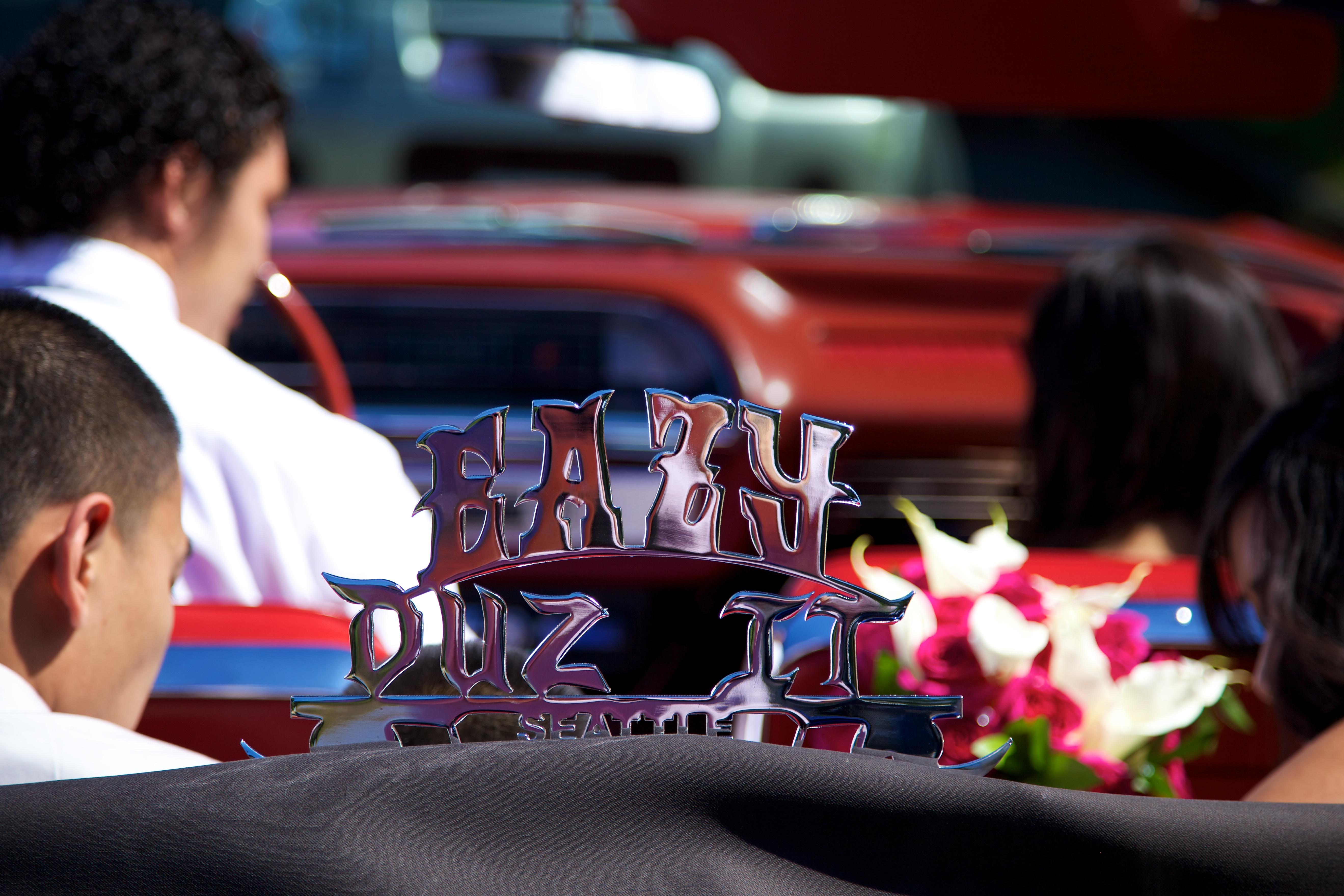
Plaque worthy. PHOTO: Bunthay Cheam
Khmerican: It looks like your team is going to debut a good amount of plaque-worthy cars this year. What should we expect from Eazy Duz It in the next few months?
Sanh: This summer, we’re going to get cars out to build and maintain a positive reputation. We’re working on memberships too. We welcome everyone but know that this is a lifetime commitment. We’ve waited too long for this. People around here make choices, go to school, gang bang; us, we’re going to push out quality lowriders. It’s a lifetime commitment. In fact, rules for the club include disassociating yourself from gangs or any other illegal activities so as not to bring trouble to the club and maintain a clean image for public consumption. We also plan to represent at a couple major car shows, perhaps work with more weddings and maybe some music videos that we’ve been asked to do.
Khmerican: By who?
Sanh: Sky High Music Group, among others, has inquired. Yung Doff, QP and them… [hip-hop artists from Seattle]
Khmerican: You touched upon helping the Khmer community. Let’s talk about what that means to you.
Sanh: Yeah, I went to Cambodia for the first time a few years back, and by the time the trip was done, I was changed, spiritually and mentally. Some things you see going there you can never prepare for. So when I got back home, my mind was going a mile a minute on what I could do for our people back in Cambodia.
One day my brother forwarded an email to me about a job with the Khmer Community of Seattle King County (KCSKC), which is recognized and designated by the City of Seattle as a Community Based Organization (CBO). It was a position that required experience doing graphic design. The pay was $10.00. But I didn’t even care, as long as they accepted, I was happy as hell. I did it, for three years, two jobs. At first I didn’t know what I was doing. They told me to make a youth program flyer but I didn’t even know how to use Adobe so I BS’d for the first month or so.
Khmerican: And then one day things just picked up?
Sanh: One day, the director decides to put me in charge of the Environmental Justice Network in Action (EJNA), a $10,000 grant from the city. We were tasked with teaching the community how to recycle, save on electricity, pollution, becoming responsible citizens, among other things. Somehow that turned into helping people fill out forms and application ranging in anything from submitting a citizenship application, filing for unemployment to helping bring a bride over from Cambodia. I took people to interviews for utility assistance, DSHS and became a “translator” for them at INS. That forced me to teach myself how to read and write Khmer. The community center held a Khmer language class for the kids and that was even more pressure on me since they’d naturally look to me for answers. There was a Khmer class, traditional music class, dance class, all that, full blast. And here I am… I had no choice but to learn to read and write the language and also learn everything about the culture.
Eventually, I decided to go back to school to not only build my credibility but to also get a job that can pay me more and so I can volunteer at the center instead of working there for money, so I had to curb my commitment and ultimately leave.
Khmerican: Hobbies and social responsibility seem to go hand in hand with you. What else would you like to share with Khmer America?
Sanh: Low riding has kept me focused on my goals and dreams. With other goals I have in life, whether big or small, some way, somehow lowriding is involved one way or another. The feeling I get when I finish a project is like no other. And since I’ve had a taste of that feeling, I now have an appetite for it, which drives me to finish any project that I start, like finishing school or doing artwork, etc. Sometimes I focus so much on what the car needs or what needs to be done with a club member’s car that I neglect things like family parties, birthdays, get-togethers, even sleep. I hardly call in sick from work, but when I do it’s related to lowriding. Car needs to get towed across state for body work: “I’m sick,” or I need to get a car ready for a show or cruise: “I’m sick.” One of the most famous and truest quotes that I feel the most and have been through that stage is: “Pay the chrome bill before the phone bill,” as Joe Ray, president of Lifestyle Car Club said.


